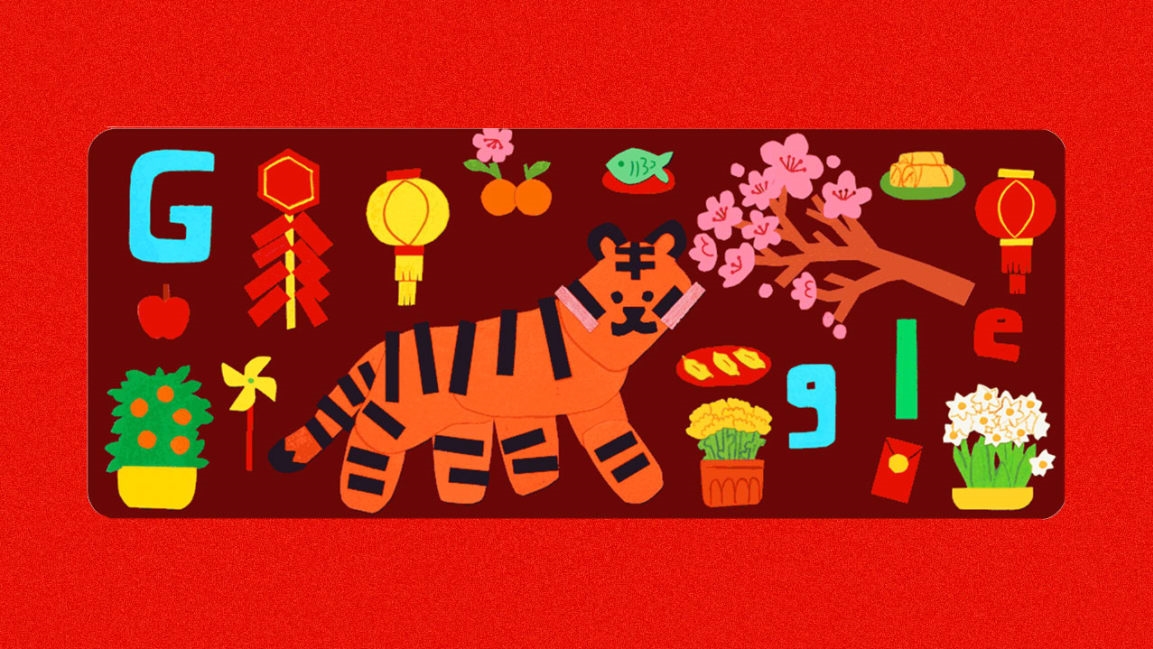
Xin nian kuai le—today is the first day of the Lunar New Year, and billions across Asia are celebrating the prospects of happiness, good fortune, and prosperity. It’s the biggest holiday of the year in many countries, with festivities in China, South Korea, Singapore, Mongolia, Tibet, and Vietnam lasting through the next few weeks.
But the Lunar New Year may reign supreme in China, whose cultural revelries compose the event that much of the world envisions—replete with paper lanterns, dragon dances, and lucky red hongbao stuffed with coins. According to the Chinese zodiac, 2022 is the Year of the Tiger—the king of the jungle in Asia—symbolizing strength and ferocity in the new season, and serving as the poster animal of the year worldwide.
To mark the occasion, Google has once again designed a custom doodle. This year’s illustration weaves together many elements of Chinese tradition into a lovely patchwork quilt, with each piece an homage to the holiday celebration.
Most prominently, there is the tiger: It spins a pinwheel with its tail to usher the turning of fortunes, and paws at the branches of a peach blossom tree, flowers showering upon its head. Peach blossoms—a sacred plant in China whose fruit represents longevity—are often used to decorate homes for the new year, along with orchids, narcissus (auspicious Chinese lilies, pictured in the doodle’s bottom right corner), and lucky bamboo, a skinnier, more lithe version of what pandas eat (it also shows up in most emoji libraries, often with a hongbao strung to it).
The doodle, however, features eight hongbao dangling from a folded paper lantern. The red envelopes are filled with money and given by parents and wedded couples to children—and sometimes unmarried adults—to inspire better luck. The cash is well-received, but the envelope itself is key; red is a lucky color, representing prosperity and fortune. (The number eight, too, is lucky; the word in Chinese, ba, is similar in pronunciation to fa, meaning wealth or riches.)
Meanwhile, lanterns, firecrackers, and the long-tailed costumed dragon—which can be seen performing kung fu kicks in new year parades worldwide—are said to frighten away evil spirits like the legendary nian creature, an ancient sharp-toothed beast that emerged from the sea once a year to feed on hapless villagers (and, naturally, brings bad luck).
Finally, every great celebration includes a feast: dumplings, fish, sticky rice cakes, and oranges, all beloved and lucky foods—sensing a trend here?—often gifted to friends, family, and the spirits of departed ancestors.
While celebrations are slightly muted this year in light of the persisting pandemic, this time of year always brings some of the most joyous moments for the Asian diaspora across the globe. In Beijing, streets were lined with red lanterns and other lucky totems—despite its COVID-19 bubble—as the city readies to host the winter Olympics this Friday. It’s the first time in the country’s history that the Olympics have overlapped with the new year; to commemorate, the organizing committee passed out miniature tiger figurines and served athletes dumplings for dinner. Meanwhile, in the United States, the Smithsonian National Zoo reunited the Chinese native giant pandas Mei Xiang and Tian Tian and their cub, Xiao Qi Ji.
Day 1 of #ChineseNewYear . @ Xidan, #Beijing pic.twitter.com/F8hiH7lpu2
— Tian Ying (@TianYing123) February 1, 2022
Female panda Mei Xiang and male panda Tian Tian enjoyed the first snowstorm of the season at Smithsonian National Zoo in Washington, D.C. ???? pic.twitter.com/6YhXWgCPo6
— Reuters (@Reuters) February 1, 2021
(32)
Report Post








